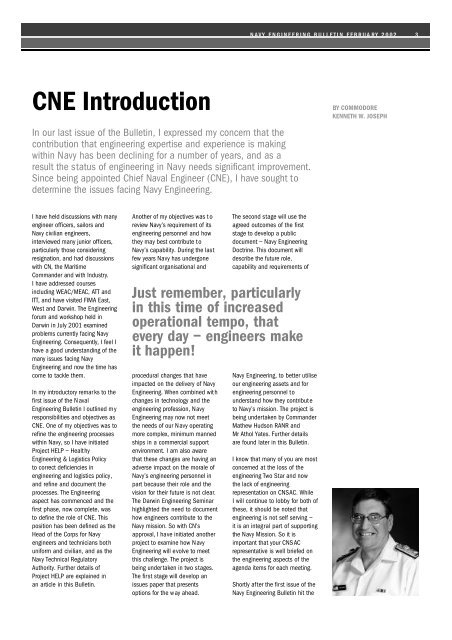ENGINEERING - Royal Australian Navy
ENGINEERING - Royal Australian Navy
ENGINEERING - Royal Australian Navy
Create successful ePaper yourself
Turn your PDF publications into a flip-book with our unique Google optimized e-Paper software.
N AVY E N G I N E E R I N G B U LL E TI N F EB R U A RY 2 0 02<br />
3<br />
CNE Introduction<br />
In our last issue of the Bulletin, I expressed my concern that the<br />
contribution that engineering expertise and experience is making<br />
within <strong>Navy</strong> has been declining for a number of years, and as a<br />
result the status of engineering in <strong>Navy</strong> needs significant improvement.<br />
Since being appointed Chief Naval Engineer (CNE), I have sought to<br />
determine the issues facing <strong>Navy</strong> Engineering.<br />
BY COMMODORE<br />
KENNETH W. JOSEPH<br />
I have held discussions with many<br />
engineer offi c e rs, sailors and<br />
<strong>Navy</strong> civilian engineers ,<br />
i n te rv i ewed many junior offi c e rs ,<br />
p a rt i c u l a rly those consideri n g<br />
resignation, and had discussions<br />
w i th CN, the Mari t i m e<br />
Commander and with Indust ry.<br />
I have addressed cours e s<br />
including WEAC / M E AC, ATT and<br />
I T T, and have visited FIMA East ,<br />
We st and Darwin. The Engineeri n g<br />
fo rum and wo rkshop held in<br />
D a rwin in July 2001 exa m i n e d<br />
p roblems curre n t ly facing Nav y<br />
E n g i n e e ring. Consequ e n t ly, I feel I<br />
h ave a good understanding of th e<br />
m a ny issues facing Nav y<br />
E n g i n e e ring and now the time has<br />
come to ta ckle th e m .<br />
In my introductory remar ks to the<br />
first issue of the N aval<br />
Engineering Bulletin I outlined my<br />
responsibilities and objectives as<br />
CNE. One of my objectives was to<br />
refine the engineering processes<br />
within <strong>Navy</strong>, so I have initiated<br />
Project HELP – Healthy<br />
Engineering & Logistics Policy<br />
to correct deficiencies in<br />
engineering and logistics policy,<br />
and refine and document the<br />
processes. The Engineering<br />
aspect has commenced and the<br />
first phase, now complete, was<br />
to define the role of CNE. This<br />
position has been defined as the<br />
Head of the Corps for <strong>Navy</strong><br />
engineers and technicians both<br />
uniform and civilian, and as the<br />
<strong>Navy</strong> Technical Regulatory<br />
Authority. Further details of<br />
Project HELP are explained in<br />
an article in this Bulletin.<br />
Another of my objectives was t o<br />
review <strong>Navy</strong>’s requirement of its<br />
engineering personnel and how<br />
they may best contribute to<br />
<strong>Navy</strong>’s capability. During the last<br />
few years <strong>Navy</strong> has undergone<br />
significant organisational and<br />
procedural changes that have<br />
impacted on the delivery of <strong>Navy</strong><br />
Engineering. When combined with<br />
changes in technology and the<br />
engineering profession, <strong>Navy</strong><br />
Engineering may now not meet<br />
the needs of our <strong>Navy</strong> operating<br />
more complex, minimum manned<br />
ships in a commercial support<br />
environment. I am also aware<br />
that these changes are having an<br />
adverse impact on the morale of<br />
<strong>Navy</strong>’s engineering personnel in<br />
part because their role and the<br />
vision for their future is not clear.<br />
The Darwin Engineering Seminar<br />
highlighted the need to document<br />
how engineers contribute to the<br />
<strong>Navy</strong> mission. So with CN’s<br />
approval, I have initiated another<br />
project to examine how <strong>Navy</strong><br />
Engineering will evolve to meet<br />
this challenge. The project is<br />
being undertaken in two stages.<br />
The first stage will develop an<br />
issues paper that presents<br />
options for the way ahead.<br />
The second stage will use the<br />
agreed outcomes of the first<br />
stage to develop a public<br />
document – <strong>Navy</strong> Engineering<br />
Doctrine. This document will<br />
describe the future role,<br />
capability and requirements of<br />
Just remember, particularly<br />
in this time of increased<br />
operational tempo, that<br />
every day – engineers make<br />
it happen!<br />
<strong>Navy</strong> Engineering, to better utilise<br />
our engineering assets and for<br />
engineering personnel to<br />
understand how they contribute<br />
to <strong>Navy</strong>’s mission. The project is<br />
being undertaken by Commander<br />
Mathew Hudson RANR and<br />
Mr Athol Yates. Further details<br />
are found later in this Bulletin.<br />
I know that many of you are most<br />
concerned at the loss of the<br />
engineering Two Star and now<br />
the lack of engineering<br />
representation on CNSAC. While<br />
I will continue to lobby for both of<br />
these, it should be noted that<br />
engineering is not self serving –<br />
it is an integral part of supporting<br />
the <strong>Navy</strong> Mission. So it is<br />
important that your CNSAC<br />
representative is well briefed on<br />
the engineering aspects of the<br />
agenda items for each meeting.<br />
Shortly after the first issue of the<br />
<strong>Navy</strong> Engineering Bulletin hit the
















